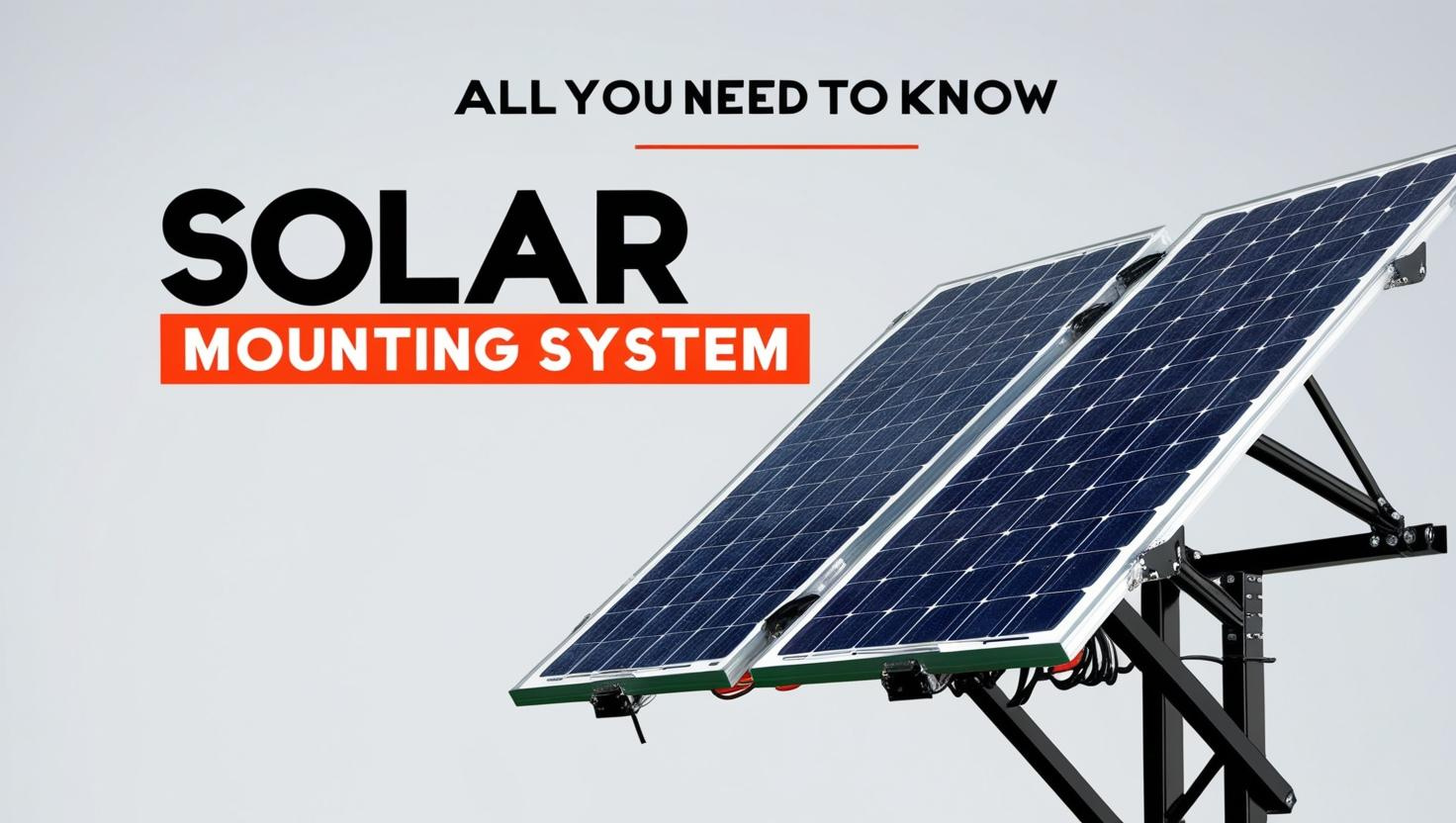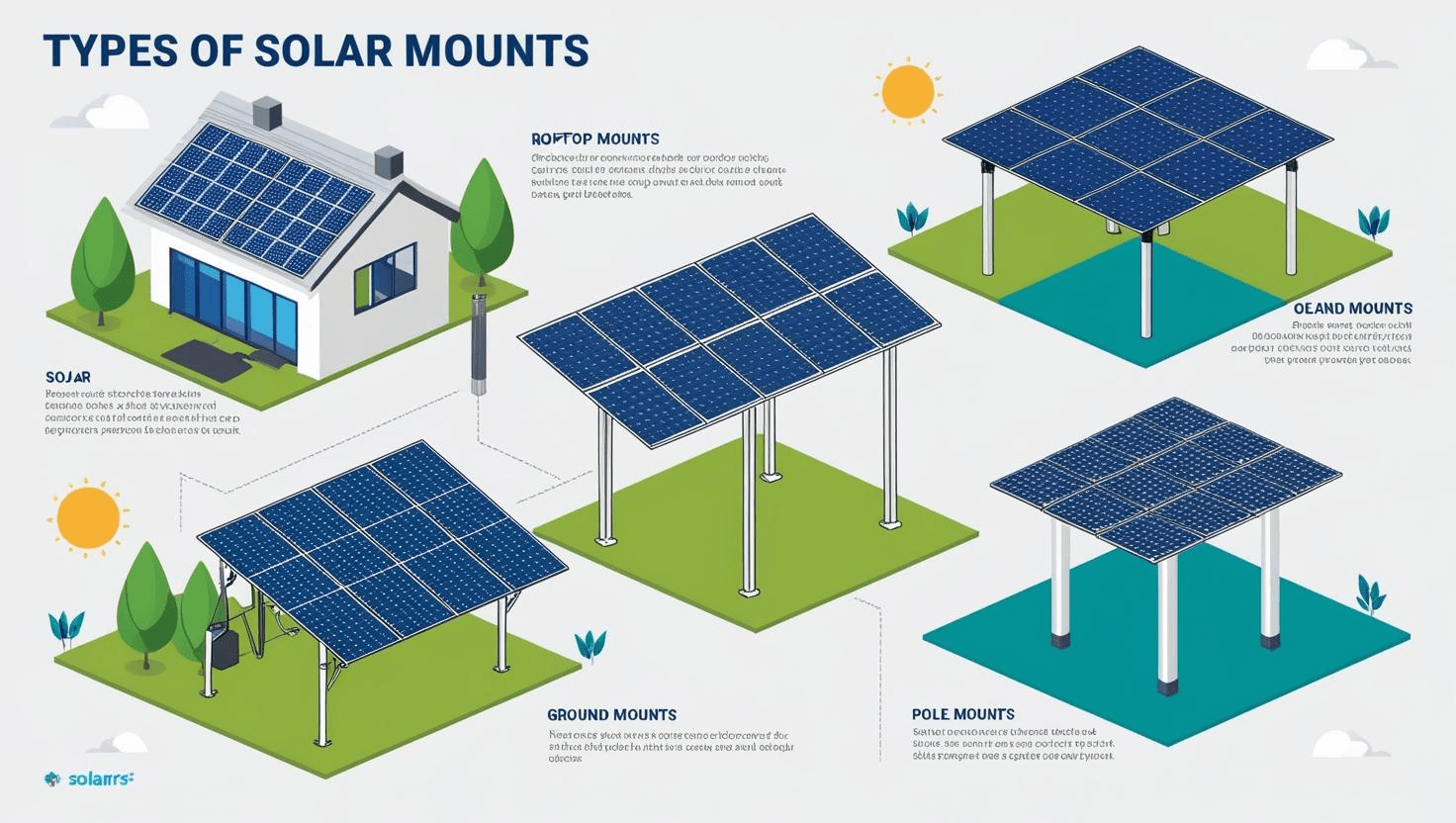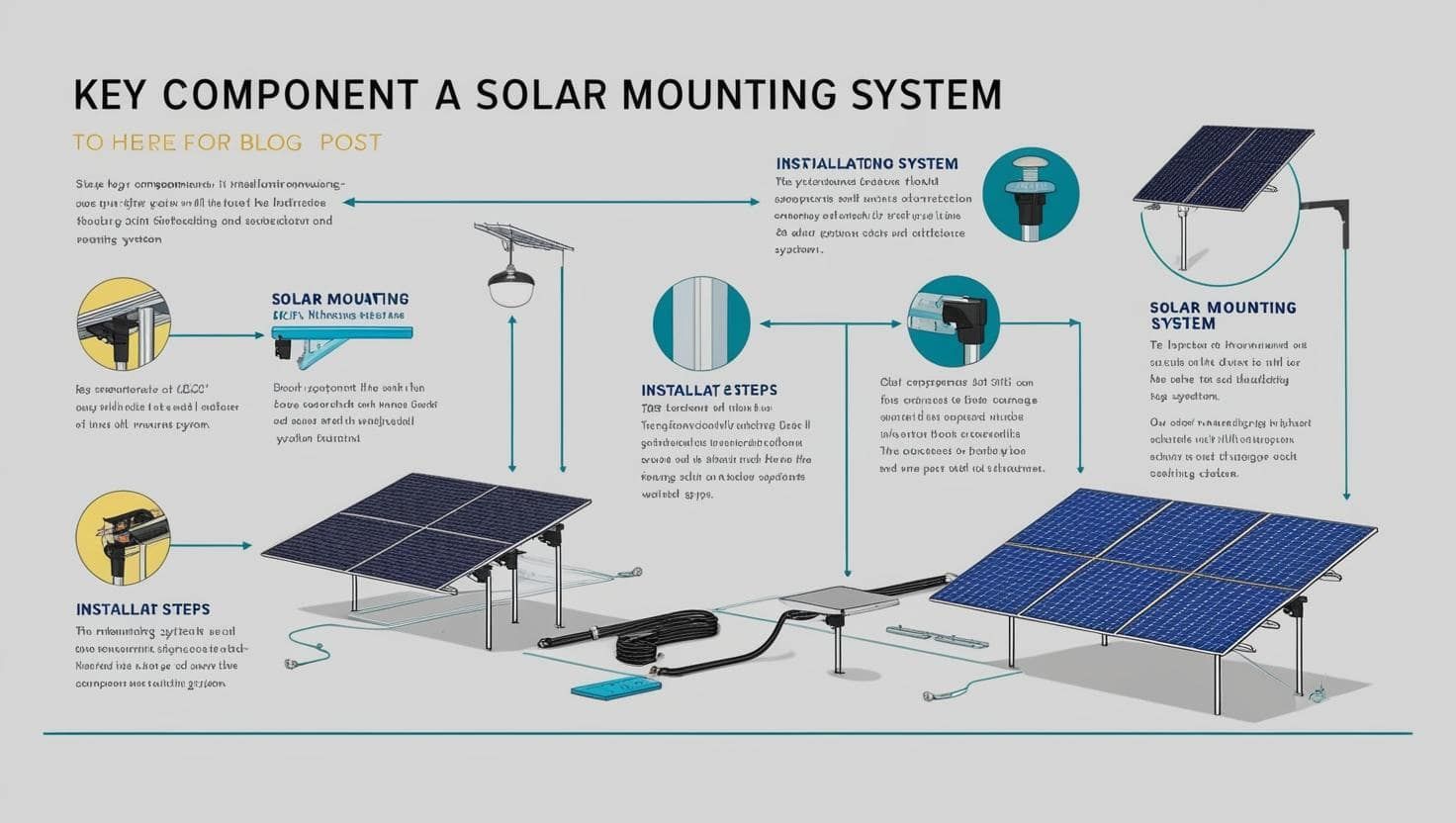
Jun 25,2025
People want solar energy systems to produce low-cost electricity with clean operating processes. However, many elements must be considered in the selection and installation process. Solar panels can not stand securely unless a mounting system is under them. Below, you will find out how crucial this solar mounting system is.
A solar mounting system is a structure or placement frame for solar panels. Solar panels need a durable and rigid structure to stand firm at any desired location. For this reason, there is a solar mounting system. It secures the position of solar panels against winds, rain, and all possible factors. A solar mounting system can secure solar panels on roofs, ground, and even water.
A solar mounting system is essential for securing single or multiple solar panels. Installers must use mounting systems to position the solar cells. A mounting system maintains a solar panel's position to absorb solar energy optimally and helps users perform maintenance conveniently. The entire performance depends on the intensity of sunlight and the panels' positioning. Therefore, a solar mounting system is as essential as any other component in a solar energy system.

The industry offers different types to meet users' feasibility. Some users can install solar mounting systems on their roofs, and some can't, so they choose other mounting systems. Below are all the types.
The most common solar mounting system is the roof one. Most residential users prefer this type because it serves an individual purpose. Anyone with a personal roof can install this type. Since different types of residential places have different roof formats, there are subcategories for them.
Flush Mounts:
They are parallel with sloped roofs and are the best choice for them. People who live in houses with sloped roofs choose this type. They impose less load on roofs and also make the least resistance to wind. Flush mounts have a z-angle or sloped position to absorb the sunlight. However, they are fixed types because they can not be adjusted at different angles once you install them.
Adjustable Mounts:
This type is helpful for homes with horizontal roofs or x-axis types. They will install solar energy systems on non-sloped roofs. Tilted mounts get sun exposure with angle adjustment features. They are adjustable mounts with flexibility in 15- and 30-degree angles.
Flat Mounts:
They are also suitable for flat roofs with accurate x-axis surfaces. The difference is that they do not incline like the adjustable mounts. They are also fixed at a specific angle of 180 degrees.
Advantages:
• Both types are ideal for residential and also commercial places.
• Roof mounting systems offer the maximum advantages to places with large roofs. Sunlight is most absorbed at the top of a house or building.
• They are more cost-effective compared to ground mounts. Ground mounts need additional safety from surrounding threats.
• They have high weather resistance and can withstand strong winds.
Disadvantages:
• Some roofs may not support mounting systems because of space and strength issues.
• This type can impose additional load on a roof. An old roof with a weak structure is unsafe for a solar mounting system.
• The penetration in the roof for the installation process of a mounting system might cause problems. It could cause leaks during rains and snowfall.
Best Applications:
Roof mounting systems suit residential, commercial, and even industrial places. They can be installed in homes, corporate buildings, and warehouses. Before Installation make sure to consider things like Location of Property, License, Batteries & Budget Limit.
People who can not install solar systems on their roofs prefer ground-mounted solar systems. They are different from the roof types because they are elevated types. Some have low elevations, and some have high elevations, depending on the kind of ground on which they are installed. Therefore, you will find a few common types used in the industry.
Concrete-Based Aluminum Mounts:
They are the basic type, similar to the roof type, but slightly different. The Concrete-Based Aluminum Mounts are essential, affordable, and great for open spaces. Its slope or angled position helps it absorb sunlight optimally. They are installed primarily on open places with even surfaces. Some residential projects use them, while the commercial and industrial sectors most support them.
Pole Mounts:
This type has a pole attached, giving it high elevation and individual installation. People who need a few solar mounting systems in a limited or small area go for pole mounts. Choose pole mounts in places surrounded by trees with large areas covered with shade. They can use tall pole structures to install solar panels that trees can not obstruct.
Tracking Systems:
This one is the most advanced one with the sun-movement tracking system. The tracker moves the solar panels in the direction the sun moves. As the hours go on, the sun also moves on. Tracking systems follow the sun's position to keep the mounts in an optimum position for maximum sunlight absorption. In simpler terms, it's like a sunflower that turns its head to follow the sun throughout the day.
There are single-axis and dual-axis tracking systems. The single-axis type moves in the east and west for optimum performance. This means it follows the sun's movement from sunrise to sunset, ensuring the panels are always facing the sun. Meanwhile, a dual-axis tracking system moves the east, west, south, and north. As a result, solar panels get full exposure to sunlight for maximum energy production, adjusting not only for the sun's daily movement but also its seasonal changes.
Advantages:
• Ground-mounted solar systems provide users with a high level of adaptability and control. The ability to adjust the x and y-axis positions allows users to precisely position their panels to face the sun, maximizing energy production. This adaptability empowers users, giving them a greater sense of control over their energy production.
• Users don’t have to climb the top of their buildings or use ladders to access the sloped roof for maintenance. Ground solar mounting systems are easier to maintain because they are easy to access.
• Ground-mounted solar systems are particularly well-suited for large-scale energy production. This makes them an ideal choice for large commercial and industrial properties that require significant energy production. The potential for large-scale energy production can inspire a sense of optimism and ambition in potential users.
Disadvantages:
• Users must arrange ample space to install ground mounts. They are not suitable for congested places and require open areas.
• The initial cost is higher and requires additional safety. Users have to install barriers to prevent trespassing.
Best Applications:
Ground mounting systems perform best in farms, factories, and agricultural fields. They are made for these places, where they can receive maximum sunlight without any obstruction from surrounding buildings. Since residential areas have less space, commercial areas are the right places for them.
The third type is uncommon because it is based on the water's surface. Some developed countries use it because of a shortage of ground areas and rooftops. Places with abundant ponds and lakes also try floating mounting systems. Their base is made of HDPE, a waterproof and lightweight material. The HDPE surface has a higher volume than its weight, which helps it float safely on the water. It can withstand multiple solar mounting systems for a long time.
Advantages:
• Users neither need space on a roof nor the ground.
• Many aquatic areas are unused, and installing a floating mounting system will not cause much problem.
Disadvantages:
• The biggest challenge is the installation process and their maintenance.
• It is hard to clean each solar cell because there is hardly any space between them. Moreover, maintaining balance is not easy at all.
• It can cause some hurdles for aquatic life by obstructing the sunlight in a specific area.
Best Applications:
Residential and commercial buildings near lakes and ponds can use a floating mounting system. These systems save ground for other uses and optimize the water surface for solar energy systems.

Following these key considerations if you are about to install a solar mounting system. Then, you can decide what kind of system you need and how much capacity you need.
The place where you will install a solar mounting system will be the primary factor. Does the sunlight reach your place ultimately? Do you get too much shade from the surrounding buildings? Do you want to install it on a roof or the ground? Are you trying to go for a floating type since a lake is near your house? Also, the kind of roof you have will play a key role. Some houses have inclined roofs and parallel surfaces to the sky. It is about sloped vs flat roof type.
Another main factor to consider is the load-bearing capacity of roofs. Installing a sizable mounting system can pose a risk of roof collapse. Before proceeding, have your roof inspected by a solar mounting expert. Likewise, inspect the terrain when choosing a ground mounting system.
The climate of your place will also be a key element to consider. Before installing the mounting system, you must consider the frequency of snow and rainfall. Also, the wind speed can affect the decision. Strong winds can pose a threat to the solar panels. You will need a type that can cause the least wind resistance.
Can you afford the number of solar mounting systems you want to install? How many do you need, and how will you install it conveniently? These questions must be in a person’s mind when purchasing. You will need to make a price comparison for the type of solar mounting system you will choose. Compare the challenges in installation and maintenance of all kinds. Do thorough research, whether it is a roof-type, ground-type, or floating-type system.
The energy production depends on how many solar panels you install. It means you will have to measure the space needed to install them. Also, the number of mounting systems will affect the space you have and the energy level you need. That means the larger your space, the more panels you can install. Another thing is that efficiency depends on selecting a solar mounting system for the right place. The angle and positioning of the solar mounting system will matter the most in the efficiency of energy production. Not everyone goes for fixed mounts, and not everyone goes for tracking mounts. It all depends on the application type you want. People who rely entirely on solar energy might like to go for a tracking type of solar mounting system. However, the cost will be a challenge for them.
Can you reach each solar panel to clean it? That is the challenge for some users when they install solar mounting systems. Some places are hard to get even if the energy production is very high. Maintenance is as essential as efficiency for panels. If you can clean them, efficiency will drop.
Moreover, installing a floating mounting system will require users to remove salt layers from the panels. If you live in a sandy area, you must clean the panels frequently, so make sure you have easy access to maintain them. This will affect the longevity of the mounting system.
A property with a solar mounting system has a higher value than one without solar panels. The addition of a solar mounting system will affect the price of the house, office, etc. So, investing in a solar energy system will also affect the property's value. Remember this factor because renting or selling the property will give you an advantage.
Here is a summary and brief comparison of all three main types of solar mounting systems. This will help you decide which suits you best.
• Suitable for places surrounded by buildings and less sunlight exposure.
• Residential users mainly use them. However, some commercial and industrial places also use them on a small scale.
• They are available in sloped and flat types to meet different roofs.
• Maintenance is more convenient than the floating mounting systems.
• They add a burden on the roofs if excessive systems are installed.
• Users may experience water leaks in the holes caused by penetration during installation.
• Its cost is less than that of the other two types.
• It is suitable for places with considerable access to open areas. Farms, agricultural lands, and factories prefer this type.
• They are available in low- and high-elevated types to meet user requirements. Thus, trees can not affect the performance of the elevated ones.
• Users need barriers for them against trespassing.
• Maintenance is more manageable than that of the roof and floating types.
• Tracking mounting types can follow the movement of the sun.
• The cost is slightly higher because of features like tracking and angle adjustment.
• This type is scarce, and users need a large water reservoir.
• It is hard to install and maintain since it floats on a lake, pond, or similar place.
• Its cost is also higher in terms of installation and maintenance.
• Users will not need large spaces on their roofs or surrounding areas. A lake or pond is enough.
Installing the correct type can provide countless benefits. These benefits come after conducting a thorough analysis and installing the right system.
The first is cost efficiency and the recovery process. ROI is faster when you know you can produce efficient energy in less time. You can recover the installation cost faster when you save lots of money. Solar energy is free, so you can save money. You can also sell excess energy to the nearest grid for extra cash.
The correct positioning of the solar mounting system will generate the maximum energy. The less shading, the higher the energy production. Some users get the best performance from a tilt mount, and some from a tracking mount. It all depends on which type suits your place.
The longer it survives, the more money you will save on energy production. Some solar mounting systems can last five years, and some can last over fifteen years. It depends on the system's quality, maintenance habits, and environmental effects.
You will have to do very little maintenance, like cleaning their surface weekly or monthly. Depending on your location, this will include positioning a mounting system. Installing the right system for ease of maintenance will make things easier. If a user can’t reach each panel, there will be problems. So, decide wisely.
Solar mounting systems are installed by selecting the proper place and type. Weather, maintenance habits, and price range are secondary factors. You must consider all these factors when choosing the right type.
1. What are the best solar mounting systems for residential places?
The roof mounting system is the best for installation and maintenance in residential places. Flat, tilt, and ground mounting systems with tracking systems are common. However, many companies are available; you can choose from a thorough analysis.
2. How much do solar mounting systems cost?
The cost depends on the size, type, and brand of solar mounting system you choose. Labor wages are also part of the installation cost.
3. Can I install a solar mounting system on a flat roof?
Yes, you can install a flat-type or tilted-type solar mounting system.
4. Are tracking solar mounts worth the investment?
They are worth the investment if you want maximum energy production. Although the maintenance and operating costs might be high, the energy production will also be high.
5. How long do solar mounting systems last?
They usually last 5 to 25 years, depending on the quality of the system and maintenance frequency.
Powered ByTradeWheel.com